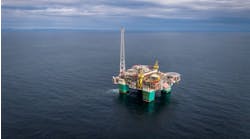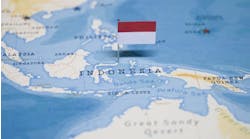Dealing with the lack of infrastructure
Richard D'Souza
Aker Engineering
- Numerous turret designs are available, with no GOM codes and standards regulating the selection process. [8,156 bytes
- Riser system water depth/diameter limits [6,439 bytes]
Many of the drivers of this anomaly may soon become things of the past with the spreading to more remote areas, technological advances, and regulatory changes. The main drivers have been:
- The existence of an extensive pipeline grid on the shelf
- No economic incentive for a large production hub
- Flow assurance concerns with subsea flowlines and risers
- High costs of subsea drilling and well intervention
- Gulf of Mexico operators' unfamiliarity with FPSOs
- Concerns about regulatory approvals.
Remote from pipelines
New leases are becoming increas ingly remote from the pipeline grid. With this major change, and the prohibitive cost of building new pipelines considered, a deepwater hub to produce and then export hydrocarbons via tanker or occasionally pipeline will be of sharply increasing interest.Subsea drilling and the use of a hub may be the only economic way to produce new hydrocarbons in some areas. Also, with technological advances, subsea flowlines and riser flow issues are not as great a concern.
Increasing globalization, which accelerates the pace of tech nology transfer, has allowed more companies to be exposed to the benefits of FPSOs. Finally, the US regulatory agency Minerals Management Service (MMS) is working with industry to develop a generic environmental impact statement.
Advantages, drawbacks
When using an FPSO, subsea wells are tied back using compliant risers to a geostationary mooring turret mounted within the vessel. The FPSO rotates (weathervanes) around the turret, minimizing oceanic stresses. Oil is stored in large tanks in the hull. Tankers offload the crude occasionally and carry it to a sales point. This method of offloading does not require production interruption, saves the occasionally prohibitive cost of pipeline construction, and also offers delivery flexibility that pipelines lack.In addition, an FPSO costs considerably less to fabricate than other floating platforms and is less sensitive to water depth and payload. Its large deck area lends itself to arrangement and integration of process facilities, and allows future expansion.
Despite these advantages, there are some drawbacks. An FPSO cannot drill, so drilling and work over must be done by expensive, dayrate deepwater mobile offshore drilling (MODU) units. Further, it lacks direct access to subsea wells. And finally, weathervaning FPSOs require all risers and mooring lines to converge at the turret, creating interference and congestion. Wave-induced vertical motion at the turret makes design for these mooring lines and risers challenging.
Regulatory considerations
- MMS: In general, the MMS has been fairly cooperative about innovations in the past. It has approved use of tension leg platforms, spars, semisubmersible platforms, and subsea tiebacks in the Gulf of Mexico. The MMS is preparing for the inevitable request to use an FPSO in the Gulf by working on a generic environmental impact statement with an industry consortium called Deepstar. Due to be complete in 2000, this effort will assist companies interested in using an FPSO in the US Gulf of Mexico to prove this production method is safe and pollution-free. This EIS will be the building block of future environ mental reviews.
- Coast Guard: Another government branch that has an interest in FPSOs is the US Coast Guard. Under an agreement between the two agencies, the MMS is responsible for industrial systems, and the Coast Guard is responsible for marine systems. Likely concerns for the USCG include hull structure integrity, collision risk, mooring system integrity, offloading, and shuttling. The International Marine Organization (IMO) does not require double-hulled permanently moored FPSOs, but the Coast Guard has not yet taken a stance. The Deepstar project could provide information that will persuade the agency to allow the monohull option. There are currently a large number of single-hull tankers which can be acquired and converted for considerably less cost than a building a new double-hull FPSO.
- Jones Act: Even if all goes smoothly with both agencies, a major stumbling block for the industry may be the Jones Act. This act of Congress would require oil shuttled from an FPSO in American waters be carried in a US-built, US-flagged tanker. There are only about 100 tankers eligible, and most of those will be phased out within five years. If tankers have to be newly built, charter rates may be considerably higher than that of non-eligible tankers.
No current code or standard
At the current time, there are no API recommendations or international standards for the design of the hull, risers, mooring systems, or marine systems. Past certifications have been cobbled together from a variety of classifications, IMO standards, and coastal authority requirements. Lack of a clear code of guidelines has caused delivery problems, project delays, and cost overruns in the past.Lack of a standard is a matter of concern, as operators in the Gulf of Mexico generally rely on API recommended practice. API will soon release a draft document which may apply, and an ISO document is now available in draft form.
FPSO design is dependent on regulatory requirements and cost. Within that framework, considerations include whether to have a single hull or double hull, and whether to convert from tankers, or newbuild.
Special considerations for the Gulf of Mexico include persistent loop currents and occasional hurricanes. Knowledge of the metocean conditions in the Gulf is essential.
Under conditions in some areas, thrusters may be required to keep stability. Knowledge of metocean data at an early planning stage will keep design revisions from becoming necessary.
Designing for fatigue in the hurricane-prone Gulf is very important and must occur early in the cycle. ISO guidelines call for design for a fatigue life of three times service life for non-inspectable connections. Other design issues include system type choices. Main systems in the FPSO include the riser system, the turret mooring system, and the fluid transfer system.
- Risers: There are three major types of riser systems: flexible pipe, steel catenary, and hybrid freestanding risers.
- Turret systems: Four proven turret systems are likely to be used in Gulf of Mexico FPSOs.The turret choice will probably be based on a comparison of cost over the life of the project and relative risk assessment. The needs of the development (whether it is a large hub or smaller host vessel), will determine whether a permanent mooring system will be used. Conditions and likely stresses will also determine the choice of bearing systems.
Turret bearing system concerns for a large, deepwater hub FPSO are: break-out torque to overcome bearing friction while unmanned; accommodation of moonpool "ovaling" due to hull girder flexing; achievement of load sharing between main and lower bearings; and ease of inspection and maintenance.
Fluid transfer systems
The fluid transfer system facilitates production fluid passage, well control, and power between the turret and the platform. There are two proven fluid transfer systems.One is the multipass swivel. It contains several separate, vertically stacked modules, which each provide a flowpath for all of the functions. The system allows the FPSO to rotate 360°, while providing pressure containment. This is the most popular choice.
In contrast, the drag chain system transfers fluids through flexible pipe that winds and unwinds on concentric tracks. The platform can only turn 270° with this system, and needs thrusters to keep its weathervaning within that sector. Four North Sea FPSOs have used this system.
Conclusions
Despite some concerns, there appear to be no reasons why FPSOs can't be used in the US Gulf of Mexico. This development option would be viable on some GoM deepwater prospects, even at current low oil and gas prices. FPSOs would probably used as:- A hub platform to produce from widely dispersed subsea manifolds or wellhead platforms
- A local host platform to produce from several separate wells or manifolds
- A multiple production unit for producing several small, isolated reservoirs or for early production of a large reservoir.;
Reference
- D'Souza, R., "Major Technical and Regulatory Issues for Monohull Floating Production Systems in the Gulf of Mexico, OTC Paper No. 10704, Offshore Technology Conference, May, 1999.
Copyright 1999 Oil & Gas Journal. All Rights Reserved.


